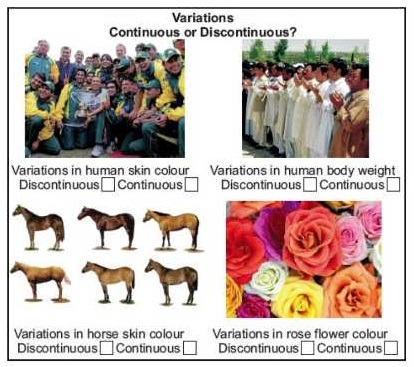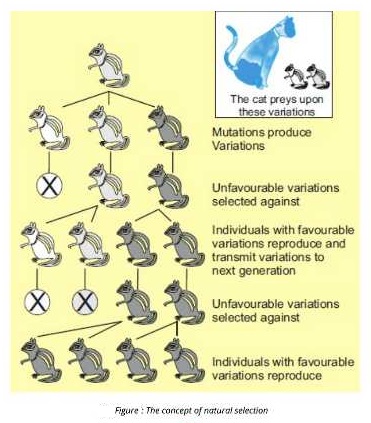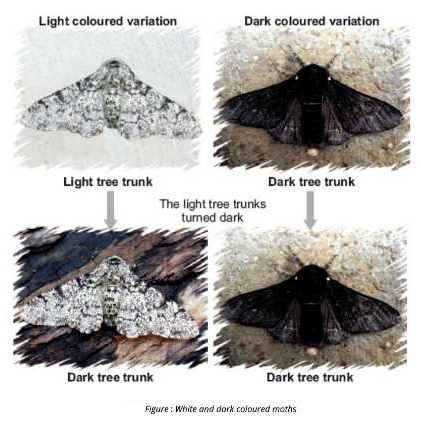Q.13 What is Biological or Organic Evolution? Explain with the help of Darwin’s theory of natural selection
Answer:
Biological/Organic Evolution
It is a change in the characteristics of a population or species of organisms over the course of generations.
The changes in an individual are not considered as evolution because evolution refers to populations and not to individuals.
Processes
Organic evolution includes two major processes:
• Alteration in genetic characteristics (traits) of a type of organism over time.
• Creation of new types of organisms from a single type.


Theory of Natural Selection
Charles Darwin (1809 – 1882) proposed the mechanism of organic evolution in 1838. It was called as “The theory of natural selection”. “Darwin proposed after his 5-year voyage on HMS (His Majesty’s Ship) Beagle. He also published a book “On the Origin of Species by means of Natural Selection” in 1859.
Early response to Darwin’s theory.
Darwin theory of evolution was not widely accepted because of lack of sufficient evidence. Modern evolutionary theory began in the late 1920’s and early 1930s.
Some scientists proved that the theory of natural selection and Mendelian genetics are the same ideas just as Darwin has proposed.
Importance of study of evolution
It determines the ancestry and relationships among different kinds of organisms.
Theory of special creation
The anti-evolution ideas support that all living things had been created in their current form only a few thousand years ago. It is known as the theory of special creation.”
MECHANISM OF EVOLUTION
Natural selection :
It is a process by which the better genetic variations become more common in successive generations of a population.
Variations in population
Almost every population contains several variations for the characteristics of its members. These variations are of two types: (i) Morphological Variations (ii) Physiological Variations
Evolutionary Fitness of Organism
The central concept of Natural selection is the evolutionary fitness of an organism.
Fitness means an organism’s ability to survive and reproduce. Organisms produce more offspring than can survive and these offspring vary in fitness.
Struggle for survival
These conditions produce struggle for survival among the organisms of a population.
Favourable variations
The Organisms with favourable variations are able to reproduce and pass these variations to their next generations.
Unfavourable Variations
On the other hand, rate of the transmission of unfavourable variations to next generations is low. It means that unfavourable variations are selected against their transmission to next generations. Examples
Skin colour in Mouse .
There are three variations in skin colour of mouse population:
• Light coloured
• Medium coloured
• Dark coloured Cat preys upon light and medium coloured mouse.
First Generation
In first generation, light coloured mouse is preyed upon by cat. Only medium and dark coloured mouse can make their next generation.

Next Generation
In next generation, population again contains light, medium and dark coloured mouse. Cat preys upon the light and medium coloured mouse. Now only dark coloured mouse make new generation.
Favourable Variations
It happens in many generations, we will see only the dark coloured mouse in the population.
Natural selection
As a result of natural selection, the alleles that give more fitness of characteristics (favourable variations) than other alleles become more common within population.
Colour Variations in Moth
In England, moths had two variations i.e.
(i) Dark coloured moth
(ii) White coloured moth .
Light coloured tree trunk
The moths used to rest on the light coloured tree trunks (on which white lichens had grown).

Favourable variations
In those days, light colour was favourable variation as they were invisible to predatory birds” while resting on light coloured tree trunks. Industrial Revolution
After industrial revolution in England, the lichens on tree trunks died due to polluted air and naked tree trunks turned dark.
The Unfavourable variation
Now the white moth variation became unfavourable or harmful because a white moth resting on dark tree trunk was easily visible to predatory birds.
Natural Selection
The natural selection selected dark moths to reproduce. In this way, dark.coloured moth became more common and at last white moths disappeared from population. In this case, the dark colour variation in moth may be considered an adaptation to environment.
Conclusion
So it is concluded that individuals with favourable yariations become major part of population while individuals with harmful or unfavourable variations become rare.
![]()